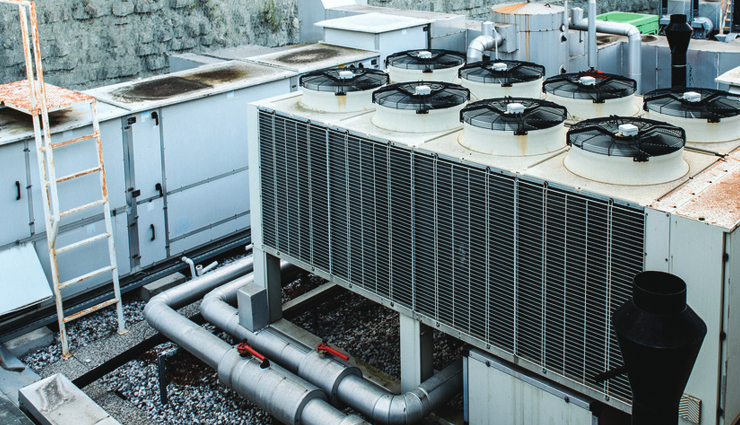Efficient Heating/Cooling: Energy-Saving Solutions
By: Priyanka Maheshwari Sun, 31 Dec 2023 11:30:06

Heating and cooling systems are essential for maintaining comfort in our homes and buildings, but they can also be a significant source of energy consumption. Inefficient HVAC systems contribute to high energy bills and environmental impact.
One energy-saving solution for efficient heating and cooling is the utilization of coil heat exchangers. A coil heat exchanger, also known as an air-to-air heat exchanger, facilitates heat transfer from one medium to another without mixing the two.
These exchangers are designed to maximize surface area, allowing more heat to be transferred at a time. They play a crucial role in HVAC systems, improving energy efficiency and reducing operational costs. This technology is an excellent strategy for those looking to lower their utility costs and reduce their environmental footprint.
In this blog post, we will explore energy-saving solutions for efficient heating and cooling, helping you reduce energy consumption and lower utility costs.
The Importance of Energy Efficiency in Heating and Cooling
Energy efficiency in heating and cooling is crucial for several reasons:
-1704001844-lb.jpg)
# Reduced Energy Consumption: Heating and cooling account for significant energy usage in residential and commercial buildings. By improving the efficiency of these systems, we can significantly reduce overall energy consumption and lower our carbon footprint.
# Lower Utility Costs: Energy-efficient heating and cooling solutions can help homeowners and businesses save money on their utility bills. You can achieve substantial cost savings over time by reducing energy waste and optimizing system performance.
# Environmental Impact: High energy consumption contributes to greenhouse gas emissions and climate change. By adopting energy-saving solutions, we can reduce our environmental impact and promote a more sustainable future.
# Enhanced Comfort: Energy-efficient heating and cooling solutions reduce energy consumption and improve comfort levels. Effective temperature control, improved air quality, and reduced noise levels contribute to a more comfortable living and working environment.
Strategies for Energy-Saving Heating and Cooling
Here are some strategies you can implement to achieve energy savings in your heating and cooling systems:

# Proper Insulation: Ensure your home or building is properly insulated to minimize heat loss in winter and heat gain in summer. Insulate walls, attics, and windows to create a thermal barrier and reduce the workload on heating and cooling systems.
# Smart Thermostats: Install programmable or smart thermostats to optimize temperature settings based on occupancy patterns. These devices allow you to schedule temperature adjustments and control your heating and cooling systems remotely, ensuring energy is not wasted when spaces are unoccupied.
# Regular Maintenance: Schedule regular maintenance for your HVAC systems to keep them operating efficiently. Clean or replace air filters, check ductwork for leaks, and ensure all components are in good working condition. Proper maintenance can improve system performance and reduce energy consumption.
# Zoning Systems: Implement zoning systems that allow you to heat or cool specific areas of your home or building independently. This way, you can avoid wasting energy in unoccupied or rarely used spaces.
# Energy-Efficient Equipment: When it's time to replace your heating or cooling system, choose energy-efficient models. Look for ENERGY STAR® certified products that meet strict energy efficiency standards. These systems use less energy and can significantly reduce your utility bills.
# Natural Ventilation: Take advantage of natural ventilation when weather conditions permit. Open windows or use window treatments strategically to let in cool breezes during summer or allow warm air circulation in winter.
# Insulated Window Coverings: Install insulated window coverings such as curtains or blinds to regulate heat transfer through windows. These coverings can help keep your space cooler in summer and prevent heat loss in winter.
# Heat Recovery Ventilation: Consider installing a heat recovery ventilation system to improve indoor air quality while recovering heat from the exhaust air. This energy-saving solution preheats or pre-cools incoming fresh air using the outgoing air, reducing the workload on heating and cooling systems.
# Shade and Landscaping: Use shading devices like awnings, trees, or shrubs strategically to block direct sunlight and reduce heat gain in summer. Well-planned landscaping can provide natural shade and also contribute to energy savings.
# Behavioral Changes: Adopt energy-saving habits like adjusting thermostats when leaving the house, using ceiling fans to circulate air, and closing curtains during hot hours. These small changes can have a significant impact on reducing energy consumption.
Efficient heating and cooling systems are essential for maintaining comfort in our homes and buildings. By implementing energy-saving solutions, we can reduce energy consumption, lower utility costs, and minimize our environmental impact.
Whether through proper insulation, smart thermostats, regular maintenance, or the use of energy-efficient equipment, there are various strategies available to improve the efficiency of heating and cooling systems.





